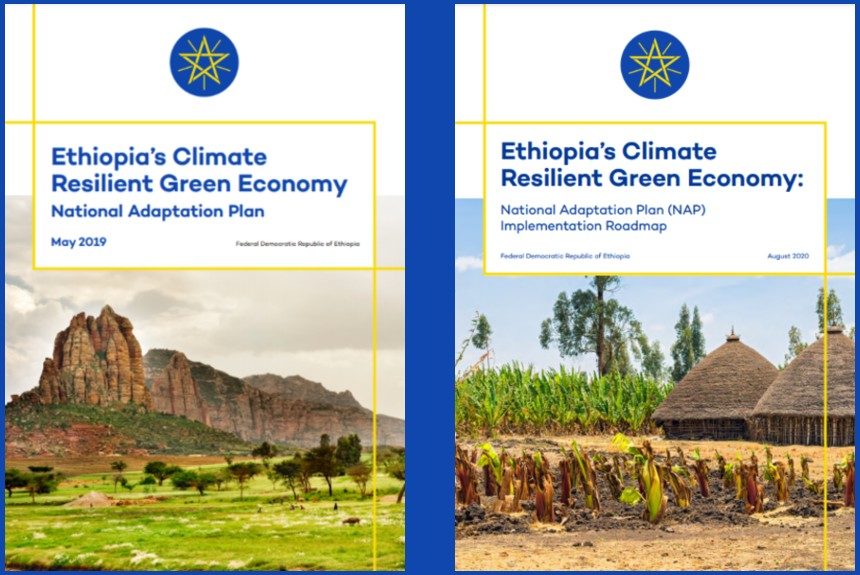Ethiopia is vulnerable to climate change impacts and the unpredictability of climate variability. The country has a weak adaptive capacity due to its limited livelihood opportunities.
Most Ethiopians depend on rain-fed agriculture and pastoral activities for their livelihood, making them vulnerable to extreme climate events like droughts, desertification, and flooding.
These climate shocks can affect water supply and can have cascading effects on human health, agriculture productivity, livestock health, and hydropower electricity production. Climate change can also increase the prevalence of diarrhea and vector-borne diseases such as malaria.
To address and reduce Ethiopia’s vulnerability, its government has developed the National Adaptation Plan to implement climate change adaptation and transform its adaptive capacity to withstand climate change impacts.
Ethiopia’s National Adaptation Plan (NAP-ETH) is developed in compliance with the country’s obligation under the Cancun Adaptation Framework of the United National Framework Convention of Climate Change (UNFCCC), which recommends that country’s put together an adaptation plan as a means to identify medium and long-term adaptation need and strategies and mandate institutional responsibility for its effective implementation.
Through Ethiopia’s enabling climate change policy environment, it established a Climate Resilient Green Economy (CRGE) strategy and mainstreamed it into its second Growth and Transformation Plan (GTPII) – Ethiopia’s long-term strategy that identifies specific activities by all sectors, as well as the roles of the NGOs and private sector to support the country’s developmental and economic growth amid numerous challenges the country is facing.
Inside the report:
- Adaptation efforts focus on highly vulnerable sectors: agriculture, forestry, health, transport, power, industry, water, and urban.
- The 18 adaptations options for the above sectors and five strategic priorities to help implement adaptation actions.
- The governance and structure mandated to implement the NAT-ETH, and bodies involved and their role and responsibilities.
- The cost of annual adaptation is US$6 billion per year, spread across 15 years.
- The monitoring and evaluation system to track progress and effectiveness in achieving the expected adaptation outcomes.
- Current and future climate of Ethiopia.
- Implementation needs which identifies the current gaps in capacity, policy, and institutional needed to implement the NAP-ETH and interventions needed such as
- capacity-development trainings,
- provision of appropriate technologies,
- enforcing appropriate policies,
- strengthening and functionalizing the existing extension system,
- enhancing the working relationship between extension and research,
- strengthening the M&E system,
- functionalizing existing government structures,
- putting in place a livestock insurance system, and
- strengthening the existing forums and platforms of stakeholders in the sector
To read Ethiopia’s National Adaptation Plan, click the link below:
An Implementation Roadmap for Ethiopia’s NAP
The Federal Democratic Republic of Ethiopia released a report in August 2020 that sets out the roadmap for implementing its NAP.
“The objective of the NAP-ETH Implementation Roadmap is to identify key enabling activities instrumental to achieving the country’s NAP, their timelines, and key milestones to note during implementation in collaboration with key actors responsible for their delivery. It will also help facilitate the implementation of actions identified through the NAP process. The NAP Implementation Roadmap will further contribute to identifying needs and gaps in relation to adaptation finance. The roadmap was developed through consultation workshops with stakeholders at federal and regional levels, a review of international experiences and nationally available key documents (including sectors’ CR strategies), and individual interviews with key actors and major implementing partners.”
CLICK the button below to read more:
Source Citation:
Ethiopia’s Climate Resilient Green Economy, National Adaptation Plan. (2019, May). Federal Democratic Republic of Ethiopia. Retrieved from https://www4.unfccc.int/sites/NAPC/Documents/Parties/Final%20Ethiopia-national-adaptation-plan%20%281%29.pdf
Ethiopia’s Climate Resilient Green Economy, National Adaptation Plan. Implementation Roadmap. (2020, August). Federal Democratic Republic of Ethiopia. Retrieved from https://napglobalnetwork.org/wp-content/uploads/2020/08/napgn-en-2020-Ethiopia-climate-resilient-green-economy-nap-roadmap.pdf



Leave a Reply